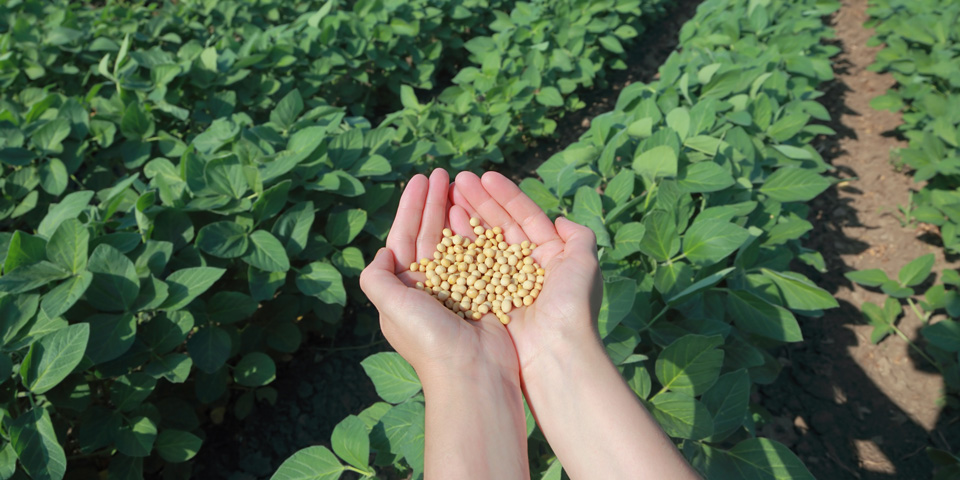
Substantial equivalence challenged by systems biology approach
The notion of the substantial equivalence of GM glyphosate-tolerant soy plants with their non-GM parents has come under renewed challenge in a peer-reviewed paper. In this case, the difference is not the glyphosate residues in the GM soy but the disruptions to biochemical pathways caused by the genetic engineering process.
Researchers Shiva Ayyadurai and Prabhakar Deonikar used a computational systems biology approach to model the effects of the genetic engineering process on key biochemical pathways affecting plant physiology.
The researchers analyzed data on GM soybeans engineered to express the CP4 EPSPS protein, which makes the soybeans tolerant to Roundup. Other researchers had previously shown that this GMO insertion up-regulates five key enzymes.
The results of the computational analysis suggest that these enzymes induce oxidative stress, leading to the accumulation of formaldehyde in the GM soybean plants, but not in the non-GM plants. This matters because formaldehyde is a known carcinogen.
All plants, as well as all bacteria and animals, make formaldehyde. But in non-GMO plants, according to the analysis, the formaldehyde remains at near-zero levels, as it is naturally cleared through a process of formaldehyde detoxification. Again, this detoxification process is common to all plants, bacteria, and animals. At the same time, in non-GMO plants, glutathione, an anti-oxidizing agent, supports the detoxification of formaldehyde and is naturally replenished.
However, in the case of GMO soybeans, the computational results indicate a depletion of glutathione along with the increase in formaldehyde. The authors comment in their paper that this is an example of how an apparently small, single, and targeted genetic modification can create large systemic disturbances in biochemical systems.
Such significant changes in formaldehyde and glutathione concentrations, if borne out by analytical testing of GM crops, could cause toxic effects on human and animal consumers of GM soy.
The authors’ conclusion is that GM soy and non-GM soy may not always be “substantially equivalent”.
This research acknowledges the complexity of biological organisms and indicates how systems biology could potentially be used to model and predict potential unexpected perturbations from GM.
These in silico predictions should motivate regulatory agencies, in conjunction with independent scientists, to develop objective standards for measuring and comparing concentrations of potentially biologically active substances in GMOs and their non-GMO counterparts as criteria for assessing substantial equivalence.
Claims of substantial equivalence do not stand up to testing
As well as in silico modeling, direct comparative analyses should be carried out. These should include transcriptomics, metabolomics and proteomics analyses to identify changes caused by the GM process. Metabolomics analysis would test actual levels of formaldehyde and glutathione.
When claims of substantial equivalence are tested using molecular analytical methods, they are often found to be untrue. Time and again, GM crops have been shown to have an unexpectedly different composition to their non-GM counterparts. This is true even when the two crops are grown under the same conditions, at the same time and in the same location – meaning that the changes are not due to different environmental factors but to the genetic modification.
Comparative analytical tests should be followed by long-term (2-year+ and multigenerational) feeding trials in rats and dose escalation trials in human volunteers. After commercialization, monitoring is necessary.
In order for these tests to be carried out, the GMO seeds and seeds of the closest non-GM relative would have to be made available to the scientists by the developer company prior to regulatory assessment.
Until such standards are developed, it is premature to approve GMOs and to consider them safe.
The papers
The citation for the new paper is:
Ayyadurai VA and Deonikar P (2015). Do GMOs accumulate formaldehyde and disrupt molecular systems equilibria? Systems biology may provide answers. Agricultural Sciences 6: 630-662. http://www.scirp.org/journal/PaperInformation.aspx?PaperID=57871&#abstract
The new paper is based on three earlier papers by teams also led by Dr Ayyadurai:
1. Deonikar P et al (2015). Discovery of key molecular pathways of C1 metabolism and formaldehyde detoxification in maize through a systematic bioinformatics literature review. Agricultural Sciences 6(5): 571-585. http://www.scirp.org/journal/PaperInformation.aspx?paperID=56818#.VXr6MOfWlnd
2. Kothandaram et al (2015). In silico modeling of C1 metabolism. American Journal of Plant Sciences 6: 1444-1465. http://www.scirp.org/journal/PaperInformation.aspx?PaperID=57220&#abstract
3. Mohan M et al (2015). Integrative modeling of oxidative stress and C1 metabolism reveals upregulation of formaldehyde and downregulation of glutathione. American Journal of Plant Sciences 6: 1527-1542. http://www.scirp.org/journal/PaperInformation.aspx?PaperID=57391&#abstract
All four papers are open access.










